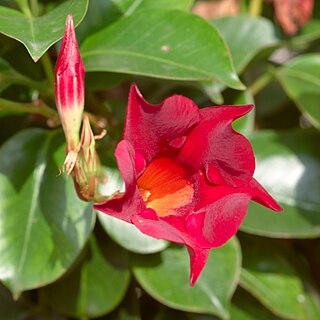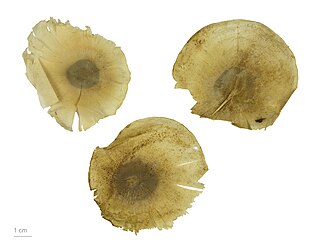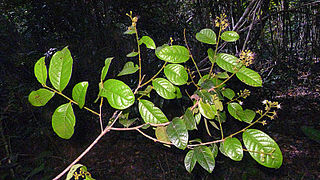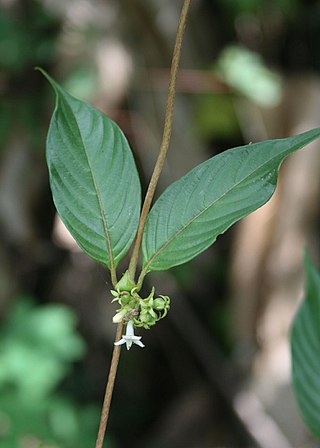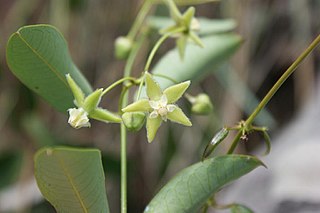| Couepia | |
|---|---|
 | |
| Couepia grandiflora | |
| Scientific classification | |
| Kingdom: | Plantae |
| Clade: | Tracheophytes |
| Clade: | Angiosperms |
| Clade: | Eudicots |
| Clade: | Rosids |
| Order: | Malpighiales |
| Family: | Chrysobalanaceae |
| Genus: | Couepia Aubl. |
| Synonyms [1] | |
| |
Couepia is a genus of flowering plants in the family Chrysobalanaceae described as a genus in 1775. [2] [3] [4] [5] [6]
Couepia is native to Mesoamerica and South America. [1]
- Species [1]
- Couepia amaraliae - Amazonas B
- Couepia belemii - Bahia, Espírito Santo
- Couepia bernardii - NW Brazil, N Peru
- Couepia bondarii - Bahia
- Couepia bracteosa - Suriname to Bolivia
- Couepia canescens - S Venezuela, Guyana
- Couepia canomensis - N South America
- Couepia carautae - Espírito Santo
- Couepia caryophylloides - Suriname, Fr Guiana, N Brazil
- Couepia cataractae - Rondônia, Pará
- Couepia chrysocalyx - NW South America
- Couepia cidiana - Pará
- Couepia coarctata - Bahia
- Couepia cognata - NE South America
- Couepia comosa - Bolívar, Guyana
- Couepia dolichopoda - NW South America
- Couepia elata - NE South America
- Couepia eriantha - N Brazil
- Couepia excelsa - Fr Guiana, N Brazil
- Couepia exflexa Fr Guiana, Guyana
- Couepia foveolata - Bolívar, N Brazil
- Couepia froesii - N Brazil
- Couepia glabra - Amazonas B
- Couepia grandiflora - Brazil, Bolivia, Paraguay
- Couepia guianensis - N South America
- Couepia habrantha - N South America
- Couepia hondurasensis - Honduras
- Couepia impressa - NE Brazil
- Couepia insignis - Bahia
- Couepia joaquinae - Fr Guiana, Amapá
- Couepia krukovii - NW Brazil, Bolivia, Colombia
- Couepia latifolia - NW Brazil, Bolivia, Colombia, Peru
- Couepia leitaofilhoi - São Paulo
- Couepia longipendula - N Brazil
- Couepia longipetiolata - Bahia
- Couepia macrophylla - NW South America, Panama
- Couepia magnoliifolia - Amazonas B, Fr Guiana
- Couepia maguirei - S Venezuela, N Brazil
- Couepia marleneae - Amazonas B
- Couepia martinii - Fr Guiana
- Couepia meridionalis - São Paulo
- Couepia monteclarensis - Bahia, Rio de Janeiro
- Couepia morii - Amazonas B
- Couepia multiflora - Guyana, Roraima
- Couepia nutans - Colombia
- Couepia obovata - trop South America
- Couepia ovalifolia - E Brazil
- Couepia paraensis - trop South America
- Couepia parillo - trop South America
- Couepia parvifolia - Rio de Janeiro
- Couepia pernambucensis - Pernambuco, Bahia
- Couepia platycalyx - Costa Rica, NW South America
- Couepia polyandra - Mexico, Central America
- Couepia racemosa - NW South America
- Couepia rankiniae - Amazonas B, Fr Guiana
- Couepia recurva - Ecuador, Peru
- Couepia reflexa - Pará
- Couepia robusta - NE Brazil
- Couepia rufa - E Brazil
- Couepia sandwithii - Venezuela, Guyana
- Couepia schottii - Bahia, Rio de Janeiro
- Couepia scottmorii - Panama
- Couepia spicata - Amazonas B
- Couepia steyermarkii - Bolívar
- Couepia stipularis - Amazonas B
- Couepia subcordata - NW South America
- Couepia trapezioana - NW South America
- Couepia uiti - Brazil, Bolivia, Paraguay
- Couepia ulei - NW South America
- Couepia venosa - SE Brazil
- Couepia williamsii - NW South America


